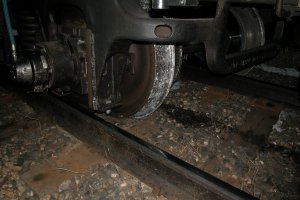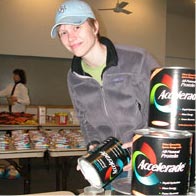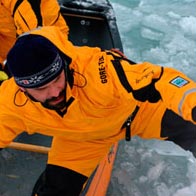March 21, 58 51.62N 094 21.52W

At 2:30 today we ran into a large section of severely pressured ice. Looking for a route through, we climbed on top of huge ice slabs folded on end. For as far as we could see, there was pressure. It would be impossible to get our slacs through that mess.
While glassing the distant ridges, we spotted a small, dark, cigar-shaped form =96 a seal. Our plan now was to ditch the canoes and get a closer look. Progress was smooth at first. We managed to find a path that angled toward the seal and what looked like an open lead. Without our slacs in tow we glided effortlessly on the fresh snow.
A slushy section caught our attention as newly formed ice and we moved even more cautiously. We were now within 100 yards of the seal. A few loud yells and the seal still lay unusually still. We mapped out a quick route through some consolidated pack in hopes of getting a closer view. We were now skiing in single file with Lonnie in the lead.
Suddenly, he was sinking. First up to his shins, then knees. As he leaned forward to grab for safetly, the ice kept breaking and sucking him down. He managed to reach behind with a ski pole and I was able to lean, grab, and give a good pull. We almost lost a ski, a pole, and never found out if the seal moved.
March 20, Button Bay

Once the film crew left, we took our first break to eat lunch. The slacs had arrived just that morning and we were able to take full advantage of them as arctic chairs.
A short ski later, we were on sea ice in front of for Prince of Wales. Built in the 1700's, it is still equipped with over 20 canons.
Travel from here involved stumbling our way over mile after mile of endless white. Weather conditions created a complete whiteout and it was impossible to distinguish any relief in the snow. One moment we were skiing on flat ice, the next found us plowing into a waste high snow drift and soon after stepping into space as we misjudged the width of the apex. For a while, the conditions were so bad that snow seemed to curve beneath our skis and over our heads. But we are camping out on the sea ice which is truly incredible.
Our new slacs have performed perfectly. They twist and turn well in the difficult pack ice yet still track nicely in the smooth snow. Lonnie's cooking has been tasty as ever and each new dinner is our favorite.
March 18, Churchill, Manitoba

"Did you feel that?" It was 4:30 am and we riding on a Via Ria train toward Churchill, Manitoba for two weeks of training and testing gear. A sharp jolt followed by a series of loud bumps made us understandably nervous.
The electrical fire, we would learn later, was simply a can of Pam falling on the grill in the kitchen car and exploding. The cause of the bump and jolt was the train derailing. When the smoke cleared, we learned that the last three cars of the train had slipped off the track. Luckily, we were able to unhook from those cars and continue on to the next town. It was the beginning of an adventure the found us in buses, small towns, restaurants and finally another train in Thompson.
After 48 hours in transit from Grand Marais, we arrived in Chuchill only four hours behind schedule. We were experiencing high adventure before even setting foot on the sea ice of Hudson Bay. Of course, we are now faced with the small dilemma of not having our boats - which didn't fit on the bus. (Although, the 120 pounds of sandbags that Eric brought along arrived unscathed.) Time now for Plan B.
Lonnie and Eric plan to ski out on sea ice and set up camp. The boats are scheduled to arrive on the train tomorrow morning. The boats will be relayed out to the pack ice where they will begin training in earnest. How will the slacs perform? Which boots will fit the best? How is Lonnie's cooking? You'll have to wait for the next update.

You're trying to cross what? When? What is it like up there? Are you crazy?
These are just a few examples of the many questions that the One World Team fields while presenting about their upcoming adventure.
If you're wondering what ice conditions will look like this summer, then this picture is for you. Open leads, melt water pools and rotten ice and not much else. Oh yea, there will be the occasional polar bear!
But realistically, this is what makes the One World Expedition so extremely difficult. Lonnie and Eric will need to travel equally efficiently over ice and water. Not such an easy task when faced with ice conditions like these.

Seven pairs of boots and nearly $4,000 later. The team's footwear is is still under evaluation.
OK, if we were undertaking a winter expedition, no problem. We'd take the boots shown above, the Norwegian Moedre Alfa Extremes. But, its not and therefore, we need boots that we be durable, light weight, not too warm, can function while wet and dry easily. Its a tall order and one that the team has not taken lightly.
To date, boots tested by Lonnie and Eric include the following manufacturers: Mendell, Fischer, Alico, Alfa and Garmont. The One World team's upcoming trip to Churchill, Mantiba will be a crucial boot evaluation time.

What would you pack for a three and a half month adventure on the Arctic Ocean? Sarah Allen, expedition graphic designer, added her elbow grease last week and divided nearly 20 gallons of powdered energy drink. Also divvied out were four gallons of olive oil, 20 pounds of dried salami, 25 pounds of dried caribou, a mountain of powdered goat's milk, 300 dried rye bread rounds, more oatmeal than you can shake a stick at and much more.
Special thanks go to Clara Weitz of Pack Lite Foods.

Training in Grand Marais - take 207. If the expedition were a movie, the director would be getting a bit tired of all the different 'takes'. The team's relentless training schedule finds them in all sorts of odd situations day after day after day. Lake Superior has proven to be an ideal location for testing equipment and travel strategies.
Inching their way along the ice, Lonnie decides it's time to hit the road - so to speak.
Thanks to Joel Sheagren for the photo.
